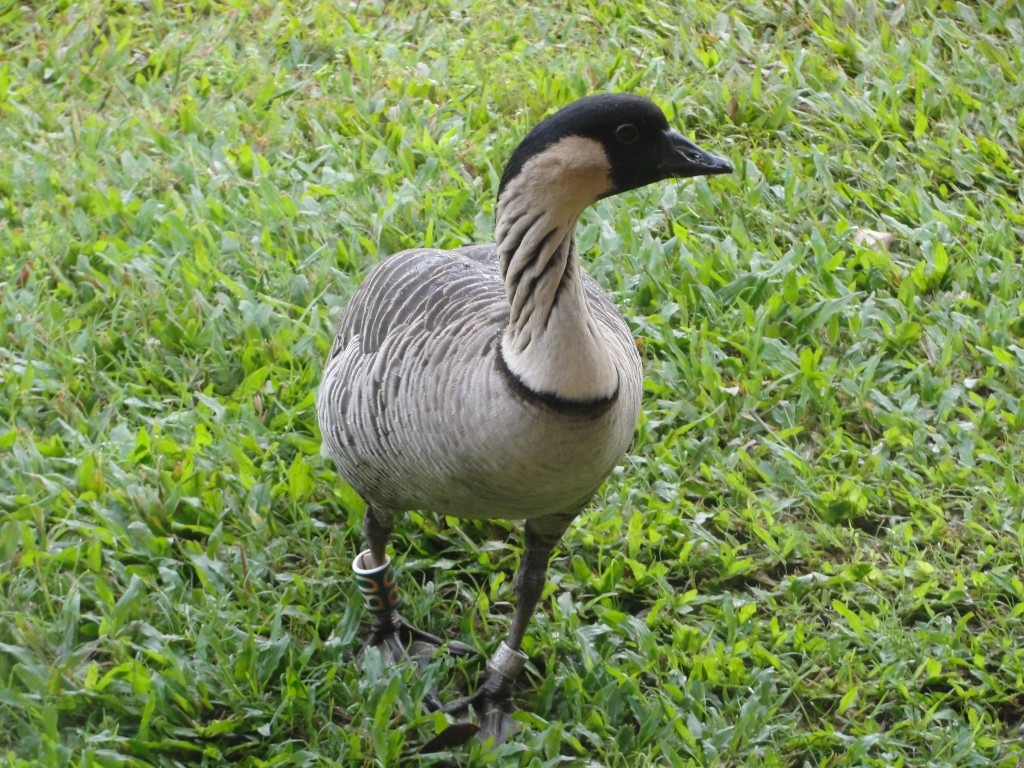
Posts Tagged ‘Canada goose’
Birds of a feather: The irony of evolution, from Canada goose to Hawaiian nene
Tuesday, March 27th, 2012
I mistook the first nene I ever encountered for a Canada goose, but who can blame me? The bird was leaving a line of droppings in the Kilauea Point National Wildlife Refuge in Kauai, Hawaii. It looked familiar but wrong, somehow, with skinny toes, black painted plumage and a fluffy white neck.

Then it honked, and I was six years old again, feeding the Canada geese on Mont Royal’s Lac Beaver. Fall in Montréal meant the end of Canada goose season. I climbed the stairs to Lac Beaver to feed the stragglers bits of bread. I watched them cross the pond, already littered with red and yellow maple leaves. They always came just close enough to snap up the treat but stayed too far away to touch. I knew they went south during the winter to get warm, like my grandmother.
If my memory could have stretched back another 500,000 years, I might have been able to reconcile my country’s eponymous travelling water bird with the strange breed of goose now honking at my feet. That’s the time frame within which ornithologists believe the Canada goose first came to Hawaii and began to evolve. DNA tests performed by the Genetics Program at the Smithsonian Institution’s National Museum of Natural History have shown that the large Canada goose is the closest living relative of the nene — an evolutionary tale that spans an ocean and half a century. Why some of those original Canada geese stayed behind and how quickly they gave rise to the nene are subject to speculation.
I think back to the nene I followed around that day across the wildlife refuge, as it waddled to its nest under a bush, and realize that bird would not exist but for an accidental migration. At some point in the last half-million years, some Canada geese were blown off course — and landed, as if by a miracle, some 6,500 kilometres away on the islands, mere specks in the sea.
I close my eyes and imagine that maiden voyage. It is perhaps not a surprise that some geese decided to stay in Hawaii, rather than fly home again. Today, the northern pintail still flies in and back to places like Saskatchewan each year. For every bird to survive that exhausting passage, I wonder about those that do not.
In the 1770s, when Captain James Cook first visited the Hawaiian archipelago, the nene was a common sight. By the 1950s, fewer than 30 remained; hunting and destruction of their wetland habitat had pushed them to the brink of extinction. Conservationist Sir Peter Scott brought half the birds to England in the early 1950s to propagate them in captivity. The Hawaiian government did the same, and today, the nene number almost 2,000 — still critically endangered, but creeping toward recovery.
That the world’s rarest goose (Branta sandvicensis) evolved from North America’s most ubiquitous goose is one of life’s little ironies, but it’s not the only one. Hawaii has spent millions of dollars to cultivate the nene; cities in North America spend millions of dollars gassing and shooting Canada geese. The nene is the sacred state bird of Hawaii; one British newspaper dubbed the Canada goose “one of Britain’s most hated birds.” Canada geese annoy farmers by eating their crops and create airplane hazards, such as the flock of Canada geese that nearly took down a United Airways flight in 2009, forcing the pilot to splashland the plane on the Hudson River in New York City.
Worst of all is their poop, befouling soccer fields and cars, public parks and estuaries. I remember visiting Boston’s Brandeis Unversity in high school on a tour of American universities. Canada geese were there, and their droppings were so thick on the ground, they looked like snowmelt.
The last thing I expected in Hawaii was to rediscover the goose of my childhood, a few thousand generations removed and very far from home. Now when I hear that familiar honking overhead, I look for the V-formation and wonder where they’re going next.
Julia Scott is a San Francisco-based journalist who flies home to Montréal in the summer, when it’s warm.
Tags: Canada geese, Canada goose, Canadian Geographic, Captain James Cook, Hawaiian goose, Julia Scott, Kilauea Point National Wildlife Refuge, nene
Posted in Feature | No Comments »
© 2025 Julia Scott.